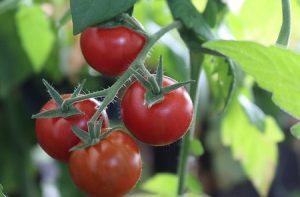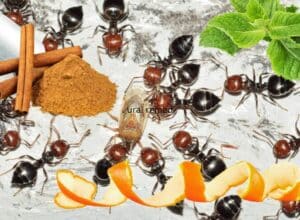Last Updated on September 30, 2023
An introductory guide to 15 mesmerizing iris types.
In this article, you’ll discover the most popular types of iris flowers (pictures and names of irises provided).
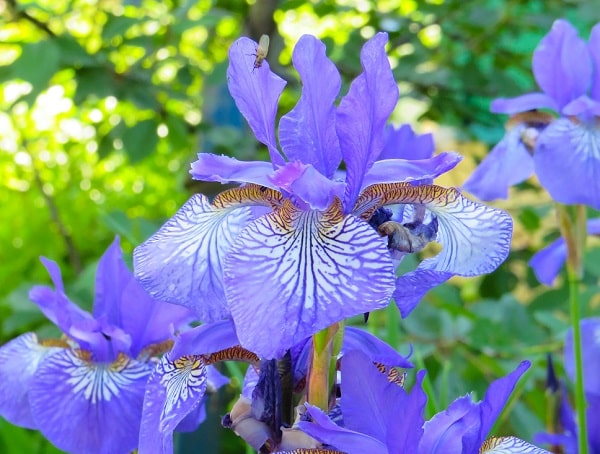
*This post contains affiliate links. If you choose to purchase any of the products I have recommended, I may receive a commission at no cost to you.
Iris Family, Iris Genus and Its Types
Irises are perennial plants that belong to the iris family, known as the Iridaceae family, which also includes crocuses, gladioli, freesias, and some other plants.
Within the iris family, irises belong to the Iris genus. This genus consists of a vast array of species and cultivars, with estimates ranging from 200 to over 300 iris species and tens of thousands of registered iris cultivars worldwide.
A Closer Look: Species vs. Cultivars
Species are plants that occur naturally, have similar traits, and can interbreed.
Cultivars are cultivated varieties developed by humans through selective breeding or genetic manipulation, with unique characteristics and propagated through asexual means.
The Iris genus includes a wide range of iris types. Each type of iris has its own distinctive characteristics, colors, and growth habits.
In this article, you’ll be introduced to the popular types of iris flowers (with pictures and names of irises, as well as their description ), but before we get to it let’s answer the most common question about irises:
What does an iris flower look like?
Iris flowers typically have six petals: three upright petals known as standards and three drooping petals known as falls. The leaves of irises are sword-shaped, adding to their unique appearance.
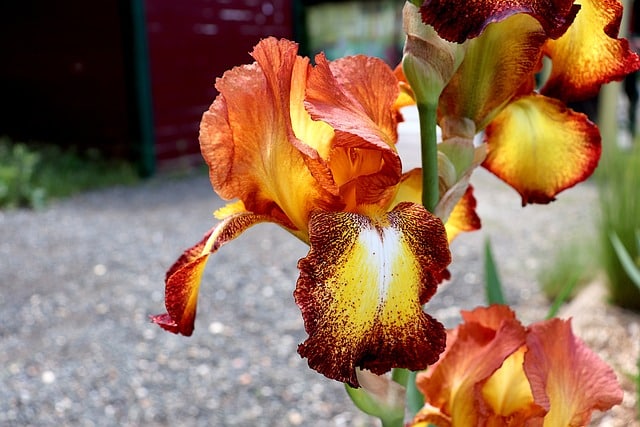
What colors can iris flowers be?
Iris flowers can come in a wide variety of colors, offering a beautiful spectrum of hues:
- Blue: ranging from light, pale blues to deep, vibrant blues
- Purple: shades of lavender, violet, and deep purple
- White: pure white or creamy white
- Yellow: bright yellows, golden yellows, and variations in between
- Orange: warm shades of orange, including apricot and tangerine tones
- Pink: soft pastel pinks to vibrant, bold pinks
- Red: rich, deep reds or burgundy shades
- Brown: earthy tones, including various shades of brown and bronze
- Black: very dark, almost black irises
- Multi-colored: some irises exhibit multiple colors or have patterns with contrasting colors
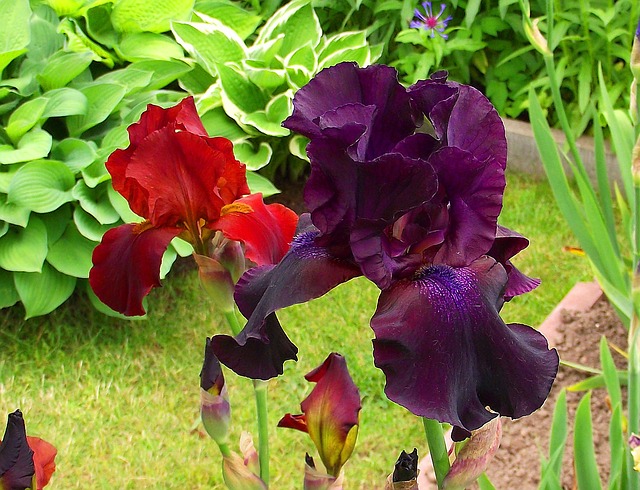
Many people commonly associate irises with colors like blue, purple, and yellow, but there are iris cultivars and species that display beautiful variations of orange, red, and brown hues. These warm-toned irises can add richness and depth to gardens and floral arrangements.
Iris flower meaning
The iris flower is often associated with wisdom, knowledge, and communication.
In Greek mythology, the iris is connected to the goddess Iris, who acted as a messenger between gods and humans. That is why the iris flower symbolizes a connection between heaven and earth, conveying messages and bridging realms.
In some cultures the iris is associated with royalty and majesty due to its regal appearance. It represents power, nobility, and luxury.
Also, In some cultures, the iris flower is considered a symbol of hope and faith. It signifies optimism, renewal, and the promise of better times.
*Please note that the meanings and symbolism of flowers can vary depending on cultural interpretations and personal associations.
Iris Types
Irises are known for their ease of cultivation and stunning flowers, so no wonder they are sought-after by gardeners and florists. And with a wide range of iris types to choose from, you’ll be able to find an iris variety that will suit your preferences.
Let’s take a closer look at 15 popular types of irises you might want to add to your garden.
1. Bearded Iris (Iris germanica)
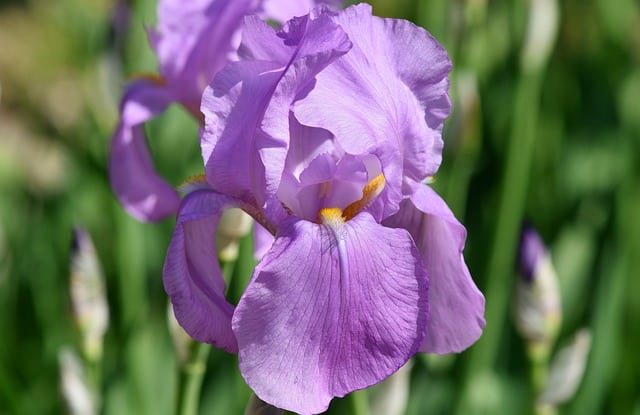
Bearded irises are one of the most popular iris types. They have large, showy flowers with fuzzy hair-like “beards” on their lower petals.
Bearded iris grows from rhizomes and can reach a height of up to 3-4 feet. Its fragrant flowers come in a wide range of sophisticated colors that typically bloom in late spring to early summer.
Some varieties of Bearded Iris are reblooming. This happens around 4-8 weeks after their initial bloom.
Are you wondering whether irises grow from bulbs or rhizomes? Discover the answer in this article.
2. Siberian Iris (Iris sibirica)
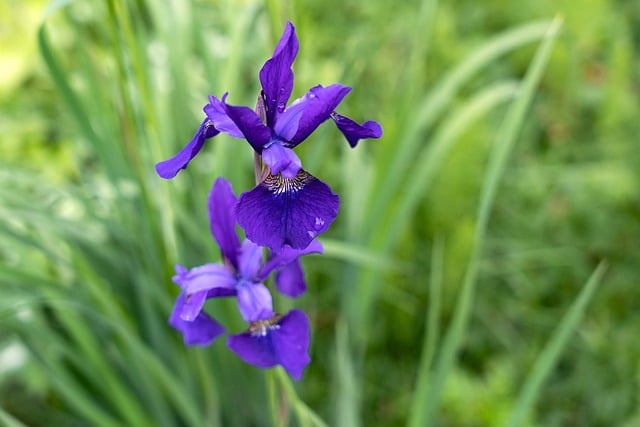
Siberian irises are known for their graceful, slender grass-like foliage and delicate flowersin shades of blue, purple, white. They typically have narrower petals compared to bearded irises.
It’ i’s a hardy iris species native to Siberia and other parts of Europe and Asia. Siberian Iris grows from rhizomes and blooms in late spring to early summer.
It’s worthy to note that Siberian Iris is well-adapted to wet soil conditions and can thrive in marshy areas.
3. Japanese Iris (Iris ensata)
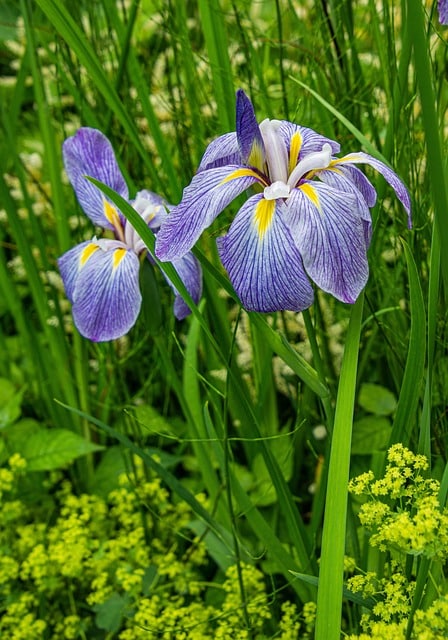
Japanese irises are prized for their unusual flowers that lack tall, upright petals in the center. Instead, Japanese iris showcases small standards and wide falls, giving the flowers a flatter appearance. The flower has a pale yellow spot known as a signal at the base of each fall that serves as a guide for bees.
These irises grow from finger-shaped rhizomes covered in fibers and thrive in moist soil. Ideally, they should be planted at the water’s edge.
4. Dutch Iris (Iris × hollandica)
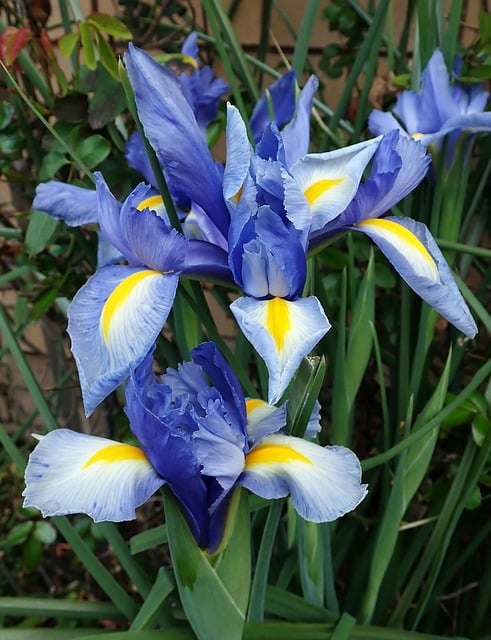
Dutch Iris grows from bulbs. It is a hybrid iris that originated from various Iris species. Dutch Iris displays striking flowers in shades of blue, purple, yellow, and white. It usually grows to a height of 1 to 2 feet.
Dutch Iris is commonly used in floral arrangements and is popular among florists for its elegant and long-lasting blooms.
Learn how to plant iris bulbs
5. Reticulata Iris (Iris reticulata)
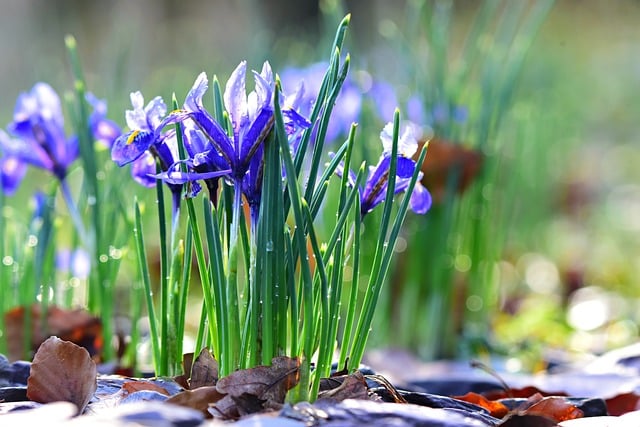
Reticulata Iris is a small-sized iris species known for its early spring blooms. Reticulata Iris produces vibrant flowers in shades of blue, purple, and yellow. It has a shorter height, usually around 4 to 8 inches.
Reticulata Iris is native to the mountainous regions of Turkey and the Caucasus. It grows from bulbs.
6. Louisiana Iris (Iris spp.)
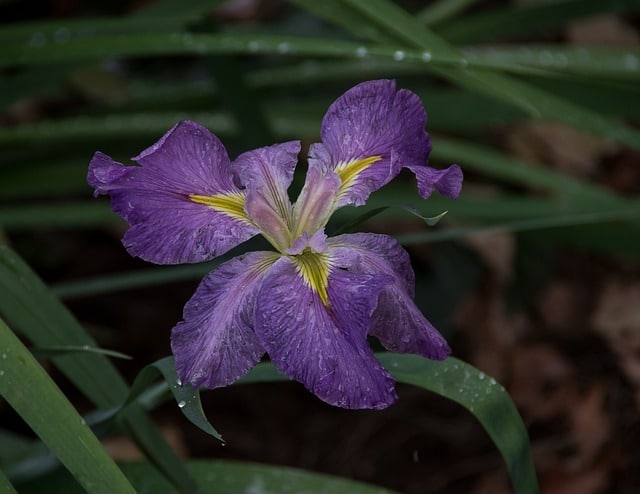
Louisiana Iris is a group of iris species native to the wetlands of the southeastern United States.
Louisiana Iris grows from rhizomes. It comes in a variety of colors, including blue, purple, and white. Its height can vary depending on the specific species, ranging from 2 to 4 feet.
Fun fact: Louisiana Iris is the state wildflower of Louisiana.
7. Pacific Coast Iris (Iris spp.)
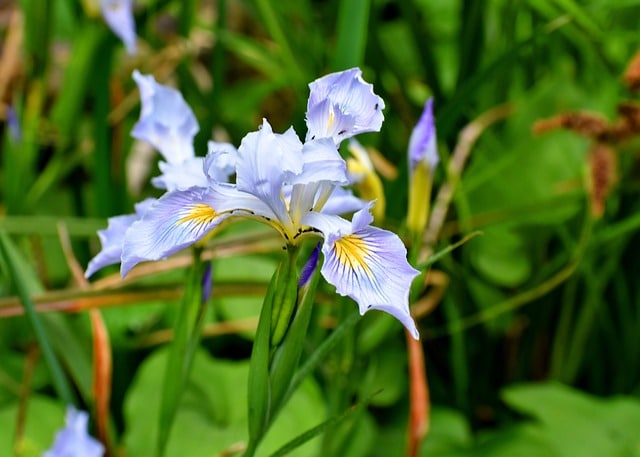
The Pacific Coast irises consist of eleven native iris species that can be found in meadows and woodlands from southern California all the way up to Washington
One striking feature of these irises is their vibrant and diverse colors that range from white, creamy-white, and yellow to various shades of blue and purple.
Pacific Coast Iris is known for its ability to adapt to a variety of growing conditions, including coastal gardens and dry slopes.
8. Oncocyclus Iris (Iris oncocyclus)
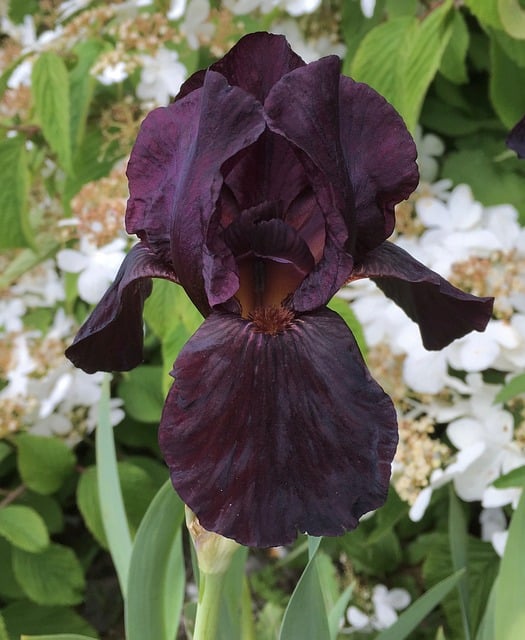
The Oncocyclus Iris is a group of irises known for their large, showy flowers that often have velvety petals with intricate markings They are considered rare and sought after by collectors of unique and exotic irises.
Oncocyclus Irises are native to regions in the Middle East and come in a range of colors, including shades of purple, brown, and yellow. These irises require specific growing conditions, they like well-drained soil and require a dry summer dormancy period.
9. Variegated Sweet Iris (Iris pallida ‘Variegata’)
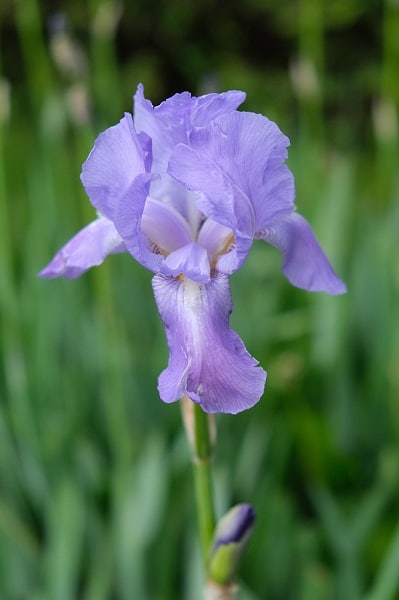
This is my favorite type of iris because it continues to look beautiful even after the blooming season. The Variegated Sweet Iris is incredibly tough and can withstand both wet and dry conditions. I grow it in my pond as well as in the front of my house, where it gets plenty of sunlight from the south.
The flowers of this iris are a lovely lavender color, and its leaves have attractive golden stripes.
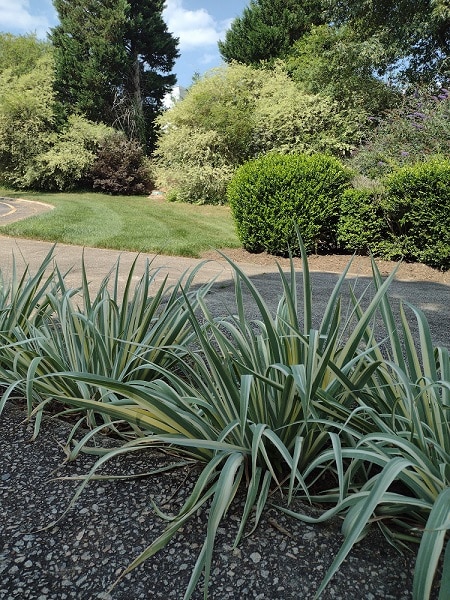
If you plant it, I’m confident you won’t be disappointed!
Read more about Sweet iris in this article about French flowers.
10. Spuria Iris (Iris spuria)
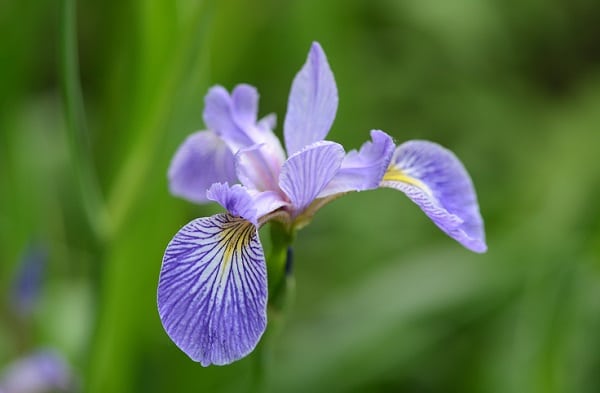
Spuria Iris is a beautiful and graceful iris species that grows from rhizomes. These tall beardless irises can reach a height of 3 to 5 feet.
One of the notable features of Spuria Iris is its orchid-like captivating flowers, which come in a variety of colors including blue, purple, yellow, and white. The foliage of Spuria Iris is also very attractive, adding to its overall appeal.
11. Crested Iris (Iris cristata)
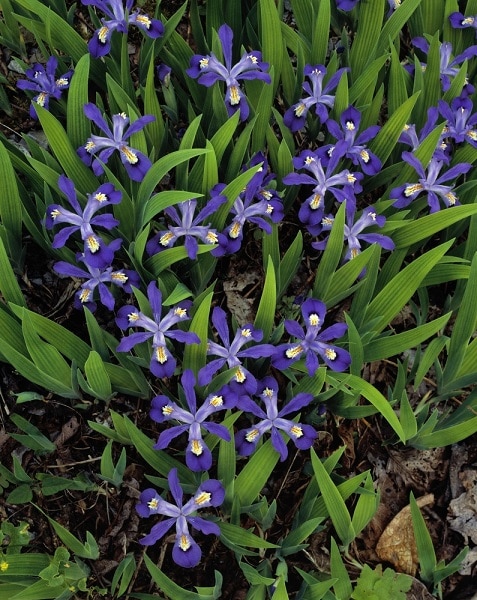
Crested iris or dwarf crested iris, is native to eastern North America. It is often found growing in woodland areas, that is why it called sometimes wood iris.
Iris cristata is a low-growing iris type that features delicate, pretty flowers with a distinctive crest-like formation on the falls. It has a spreading habit and makes attractive groundcover in shady garden areas.
12. Spanish Iris (Iris xiphium)
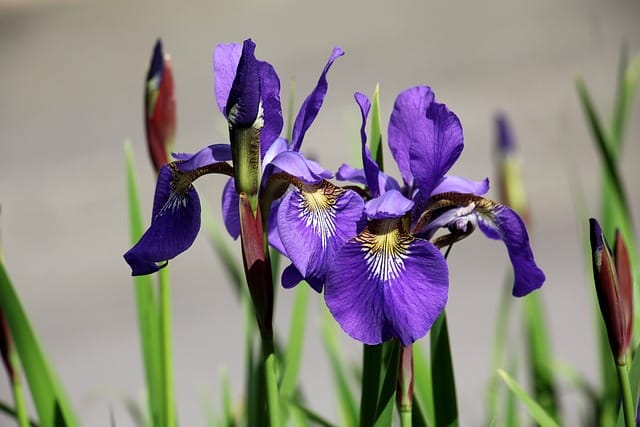
Spanish irisis a beautiful flowering plant that grows from bulbs. It has long, slender leaves that resemble swords, giving it the nickname “sword lily.” The plant produces tall stems with elegant flowers in a variety of colors. This palnt can reach a height of 2 to 3 feet.
This kind of iris is very adaptible – it can tolerate a wide range of soil conditions, including sandy or clayey soils
13. Yellow Flag Iris (Iris pseudacorus)
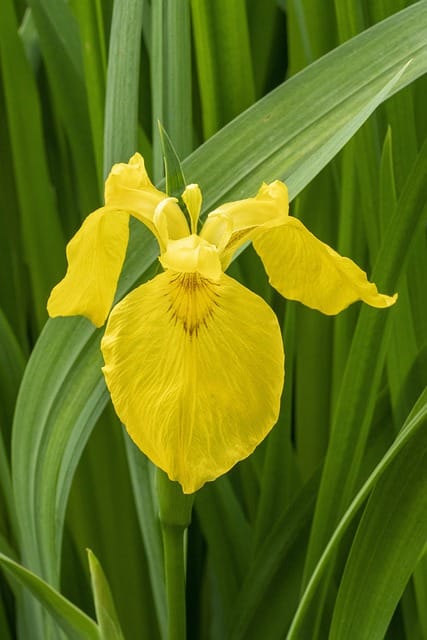
The Yellow Flag Iris is a robust iris type with vibrant yellow flowers. It’s commonly found near water bodies, such as ponds, lakes, and wetlands, where it thrives in moist or even submerged conditions. It is known for its ability to stabilize shorelines due to its extensive root system.
Yellow Flag Iris can grow quite tall, typically reaching heights of 3 to 5 feet. This type of iris grows from rhizomes, which help it spread and reproduce.
14. Japanese Roof Iris (Iris tectorum)
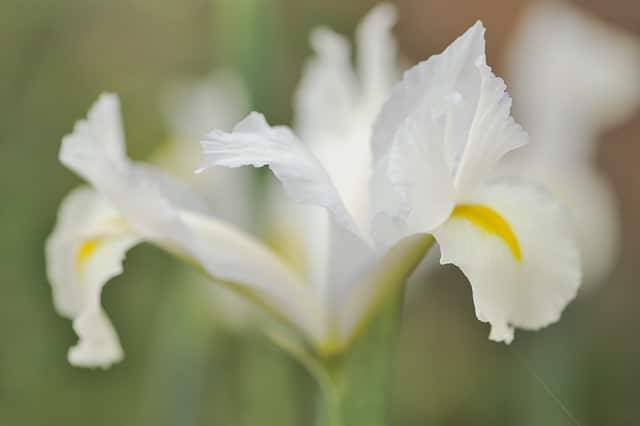
These irises are named for their ability to grow on thatched roofs in Japan. They grow from rhizomes and produce attractive elegant flowers in shades of purple, blue, and white. Japanese Roof Iris has a moderate height, averaging around 1 to 2 feet.
15. Stinking iris or Gladwyn (Iris foetidissima)
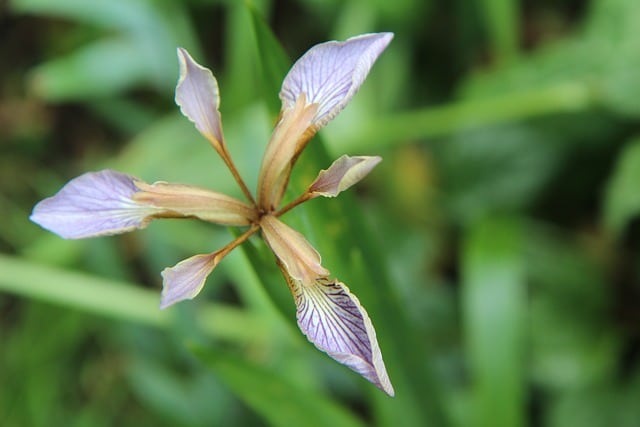
Gladwyn Iris (Stinking iris or Roast Beef plant) is native to Europe and parts of western Asia. It is called “foetidissima” due to the unpleasant scent emitted by its crushed leaves.
This iris species produces attractive sword-shaped foliage and showy flowers in shades of purple, violet, or yellow. Many people grow this iris not primarily for its flowers, but for its showy seed pods. After flowering, the Stinking Iris forms ornamental seed pods that split open, revealing bright orange-red (sometimes referred to as coral) seeds. The unique and colorful seed pods add to its visual appeal and make it a sought-after feature of this particular iris species.
Related reading:
- Tips on contaainer flower gardening
- 15 French flowers for your garden
- How to plant iris bulbs
- Types of Money Plants
- 70 Fun Facts about Flowers
- 40 Herbs for a garden – un ultimate guide
- 85 amazing Facts about Roses
- 65 Mind-Blowing Sunflower Facts
- 45 side yard ideas
More useful articles on growing flowers
Final thoughts on types of irises
To sum up:
- Iris types refer to the different categories or varieties of irises that exist within the Iris genus
- There are many types of irises, such as Bearded Iris, Siberian Iris, Pallida iris, Oculus iris, Reticulata iris, Japanese Iris, Louisiana Iris, Crested iris, Spuria iris, Dutch and Spanish Iris, etc.
- Each iris type has its own distinct characteristics, including flower shape, color, size, growth habit, and preferred growing conditions
- These different types of irises offer a wide range of choices for gardeners and allow you to select irises that suit to your preferences and your garden requirements.
You have read:


